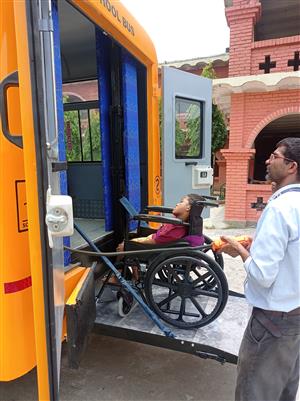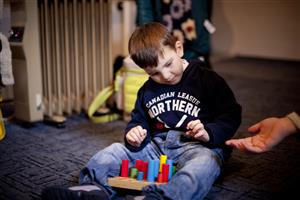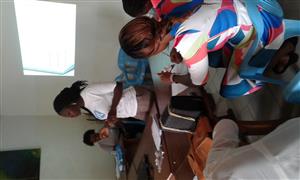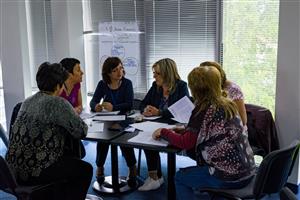Search Results
Search
Filter results
Advanced Filters
Your search returned 562 Solutions
-
Sign bilingual education from infancy to secondary school
Deaf and hearing students study together in the same classroom, receiving sign language and oral instructions simultaneously. The courses are available in signed and spoken languages, using Hong Kong Sign Language, Cantonese, Mandarin, and English. In 2019, 124 deaf children enrolled in the programme.
Chinese University of Hong Kong, Centre for Sign Linguistics and Deaf Studies, Sign Bilingualism and Co-enrolment in Deaf Education Programme, China -
Training teachers of mainstream schools in sign language
The project focuses on training teachers in rural areas to include sign language in their lessons, along with providing educational materials and assistive devices to students with disabilities. Since 2003, in-service training has been provided for 2,000 teachers and more than 35,000 deaf or hard of hearing children have accessed education.
ELF - Evangelical Lutheran Church of Finland, Felm, Social and Educational Programme for the Deaf, Ethiopia -
A full chain of support from primary school to employment
LIFE is a programme for inclusive vocational education and employment for people with disabilities, starting as early as primary school and ending with job placement. 2012 it was introduced in Armenia. By 2016 approximately 900 persons were placed in training and 653 persons were employed through the programme.
Save the Children Armenia, Livelihood Improvement through Fostered Employment (LIFE), Armenia -

A provincial government creating large-scale enrolment of pupils with disabilities in cooperation with a foundation
Disability Prevention and Rehabilitation Programme, Nepal: A partnership between Koshi Province and Karuna Foundation Nepal since 2008. Constructed 35 accessible schools, enrolling 1,267 children with disabilities. By 2023, expanded DPRP model throughout Koshi Province, with Nepal's government piloting it in other provinces.
Disability Prevention and Rehabilitation Programme (DPRP), Nepal -
Large-scale campaign to identify and enrol children with disabilities in Senegal
APPEHL follows a multilevel approach to make mainstream schools more inclusive. For children and parents, the programme includes awareness raising measures and training in dealing with impairments. For schools, learning materials are adapted and teachers are trained by teachers from the special education sector.
Humanity & Inclusion Senegal, Full Participation of Children with Disabilities in Education Programme (APPEHL), Senegal -
Fast-growing, easy-to-replicate methodology to evaluate and improve inclusion in schools
Perkins School for the Blind, U.S.: Supports global education for children with disabilities. Through the Model Program Approach, reached over 1 million children via 133 programs in 15 countries by June 2023.
Model Program Approach, Mexico -

Creating inclusive pre-school institutions
Working with the Ministry of Education and local departments, this project succeeded in enrolling 367 children with disabilities in pre-school institutions in seven regions of Kosovo. In addition, cooperation between schools, families, municipalities, rehabilitation centres and authorities was established, benefiting more than 7,500 children.
Save the Children International, Kosovo -
Inclusive education programme for children with disabilities in sub-Saharan Africa
Appui au Développement de l’Enfant en Détresse (ADED), Congo: Implemented the Tunafasi Programme in Uvira region for quality inclusive education. Raised school attendance from 5% to 68.5% between 2020 and 2023.
Tunafasi, Democratic Republic of Congo -

Subscription-based online education platforms that also work without internet
Kamer Big Bang is an online resource centre for matching users with jobs and learning opportunities. educlick is a mobile phone-based e-learning system whereby users undertake courses via text message. Originally targeted to people displaced through armed conflict, both platforms became popular with people with disabilities.
EduClick, Kamer Big Bang platform and educlick platform, Cameroon -

A systematic approach to creating inclusive school environments
"One school for All" is the first whole school approach to Inclusive Education in Bulgaria. The two-year programme offers schools a structured and systemic approach in four key areas: school leadership, teaching practices, partnership with parents, and child safety. In Bulgaria, the programme costs around € 5,200 for a school.
Association for Shared Learning ELA, One School for All – a model for creating inclusive school environments, Bulgaria
- Page 1
- Page 2
- Page 3
- Page 4
- Page 5
- Page 6
- Page 7
- Page 8
- Page 9
- Page 10
- Page 11
- Page 12
- Page 13
- Page 14
- Page 15
- Page 16
- Page 17
- Page 18
- Page 19
- Page 20
- Page 21
- Page 22
- Page 23
- Page 24
- Page 25
- Page 26
- Page 27
- Page 28
- Page 29
- Page 30
- Page 31
- Page 32
- Page 33
- Page 34
- Page 35
- Page 36
- Page 37
- Page 38
- Page 39
- Page 40
- Page 41
- Page 42
- Page 43
- Page 44
- Page 45
- Page 46
- Page 47
- Page 48
- Page 49
- Page 50
- Page 51
- Page 52
- Page 53
- Page 54
- Page 55
- Page 56
- Page 57